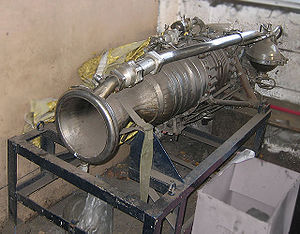- De Havilland Spectre
-
Spectre Spectre rocket engine ' Country of origin United Kingdom Manufacturer de Havilland Liquid-fueled engine Propellant hydrogen peroxide / kerosene Performance Thrust 8,000 lbf (35.7 kN) (full power) The de Havilland Spectre was a rocket engine built by de Havilland in the 1950s. It was one element of the intended mixed powerplant for combination rocket-jet interceptor aircraft for the Royal Air Force, such as the Saunders-Roe SR.53.
Contents
Design and development
The Spectre was a bipropellant engine burning kerosene and hydrogen peroxide. The power could be controlled from 10-100% delivering 8,000 lbf (35.7 kN) of thrust at full power. In the SR.53 it used the same fuel tanks as the turbojet engine and if run at full power was expected to consume the full load in about seven minutes.
In 1952 static testing commenced with the Spectre DSpe.l. The aircraft industry had no precedent for an engine which would gain in thrust with altitude and the required maximum thrust was estimated at between 2,000 lbf (8.9 kN) and 15,000 lbf (67 kN) thrust. The design was based on a variable thrust which could be throttled from 8,000 lbf (36 kN) to 2,000 lbf (8.9 kN). Design philosophy was matched to the mixed power concept of an aircraft having both a turbojet and rocket engine for maximum operational flexibility.[1]
Technological innovation embraced the Barske high-speed open-impeller centrifugal pumps,[2] as formerly researched in the Walter organisation, regenerative cooling with pump stages both upstream and downstream, gauze catalyst packs, low-loss internal-flow turbine and the use of straight kerosene fuel. The aircraft tanks were to be pressurised to suppress pump cavitation problems.[3]
It went through rig tests commencing in 1953, bench tests from mid-1954, and testing in two Canberras. From flight approval in Autumn 1956, flight experience again posed altitude starvation problems. Clearance was given for flight in the SR.53 prototype from May 1957.[4][5]
In October 1957 a contract was announced for a more advanced version of the aircraft as the SR.177 to utilise a revised design Spectre DSpe.5 engine together with a reheated supersonic capability 14,000 lbf (62 kN) thrust Gyron Junior turbojet engine, thus meeting a full mixed power aircraft concept. In conjunction with the new engine, development had been undertaken with two major ancillaries, a peroxide starter for the gas turbine and a peroxide auxiliary power unit. Virtually on the heels of the announcement of the contract came the notorious 1957 Defence White Paper declaring that all future combat would be undertaken by computer controlled missiles, and that manned interceptors were now considered obsolete.
Development flying of the SR.53 continued through 39 flights operating to Mach 1.33, and to altitudes at 55,000 ft (17,000 m), as research and construction proceeded on the SR.177, until its cancellation in 1958.
After merging of interests in 1959, it was manufactured by Bristol Siddeley.
The Spectre project was cancelled in October 1960, at a reported total cost of £ 5.75 million.[6]
Variants
Variants included:
- Dspe.1 initial version
- Dspe.2 constant thrust version, simpler design
- Dspe.3 development of Dspe.1 with variable thrust
- Dspe.4 development of Dspe.2
- Dspe.5 further development of Dspe.1
Double Spectre
A doubled version of this engine was used for early flight-testing of Blue Steel nuclear stand off bomb, with two chambers arranged vertically.[7]
The conventional Spectre DSpe.5 had been developed alongside a DSpe.4 RATO variant, the latter for the Avro Vulcan and Handley-Page Victor V bombers, another programme subsequently cancelled after a single trial take-off of a Victor from the de Havilland aerodrome at Hatfield. These two engines were then used in combination to power the development rounds of the Blue Steel missile stand-off bomb, together with the peroxide APU, from its first flight in October 1959.
References
- ^ "More About the Super Sprite". The Aeroplane. 29 July 1955.
- ^ Barske, U. M. (1960). "Development of Some Unconventional Centrifugal Pumps". Proc. IMech Engrs, 174 (11).
- ^ W. N. Neat, (14 November 1958). "Development of the Spectre (Lecture to Royal Aeronautical Society)" (PDF). Flight. http://www.cue-dih.co.uk/aerospace/aeropdfs/htp_for_prop.pdf.
- ^ "Enterprise in Rocketry Activity at De Havilland Engine Co." (PDF). The Aeroplane. 4 March 1955. http://www.cue-dih.co.uk/aerospace/aeropdfs/htp_for_prop.pdf.
- ^ "Spectre". Skomer. http://www.skomer.u-net.com/projects/spectre.htm.
- ^ "Cancelled projects: the list up-dated" (PDF). Flight: 262. 17 August 1967. http://www.flightglobal.com/pdfarchive/view/1967/1967%20-%201672.html.
- ^ "Double Spectre" (image). Skomer. http://www.skomer.u-net.com/projects/sr53.htm.
- ^ From All Quarters. "Britain's New Engines" (PDF). Flight: 572. 6 May 1955. http://www.flightglobal.com/pdfarchive/view/1955/1955%20-%200572.html.
- ^ "Paris Show" (PDF). Flight: 838. 1955. http://www.flightglobal.com/pdfarchive/view/1955/1955%20-%200840.html.
- ^ "Spectre" (PDF). Flight. 5 August 1955.
- ^ "Rocket Motors" (PDF). Flight 68 (2432): 395. 2 September 1955. http://www.flightglobal.com/pdfarchive/view/1955/1955%20-%201281.html.
- ^ "At Farnborough Next Week" (PDF). Flight 68 (2432). 2 September 1955. http://www.flightglobal.com/pdfarchive/view/1955/1955%20-%201223.html.
- ^ "Tomorrow's Engines" (PDF). Flight: 450. 9 September 1955. http://www.flightglobal.com/pdfarchive/view/1955/1955%20-%201336.html.
- ^ "de Havilland engines 1957" (PDF). Flight: 297–298. 8 March 1957. http://www.flightglobal.com/pdfarchive/view/1957/1957%20-%200295.html.
- ^ "Spectre" (PDF). Flight. 5 August 1957.
- ^ "Spectre" (PDF). Flight: 245. 23 August 1957. http://www.flightglobal.com/pdfarchive/view/1957/1957%20-%201157.html.
- ^ Britain's Rocket Engines. "Spectre" (PDF). Flight: 336. 30 August 1957. http://www.flightglobal.com/pdfarchive/view/1957/1957%20-%201248.html.
- ^ "Spectre DSpe.4 ATO unit" (PDF). Flight: 178–179. 7 February 1958. http://www.flightglobal.com/pdfarchive/view/1958/1958%20-%200170.html.
- ^ "Spectre development history" (PDF). Flight. 14 November 1958.
- ^ Aero engines, 1959. "Spectre" (PDF). Flight: 392. 20 March 1959. http://www.flightglobal.com/pdfarchive/view/1959/1959%20-%200795.html.
- ^ Aero engines, 1961. "Spectre" (PDF). Flight. 20 July 1961. http://www.flightglobal.com/pdfarchive/view/1961/1961%20-%200979.html.
de Havilland aero engines Piston engines Ghost · Gipsy · Gipsy Junior · Gipsy Minor · Gipsy Major · Gipsy Six · Gipsy Queen · Gipsy Twelve · Gipsy King · Iris
Turbojet Ghost · Goblin · Gyron · Gyron Junior
Turboprop/turboshaft Rocket Sprite · Super Sprite · Spectre
Designers Lists relating to aviation General Aircraft (manufacturers) · Aircraft engines (manufacturers) · Airlines (defunct) · Airports · Civil authorities · Museums · Registration prefixes · Rotorcraft (manufacturers) · TimelineMilitary Accidents/incidents Records Categories:- Aircraft rocket engines
- De Havilland aircraft engines
Wikimedia Foundation. 2010.

